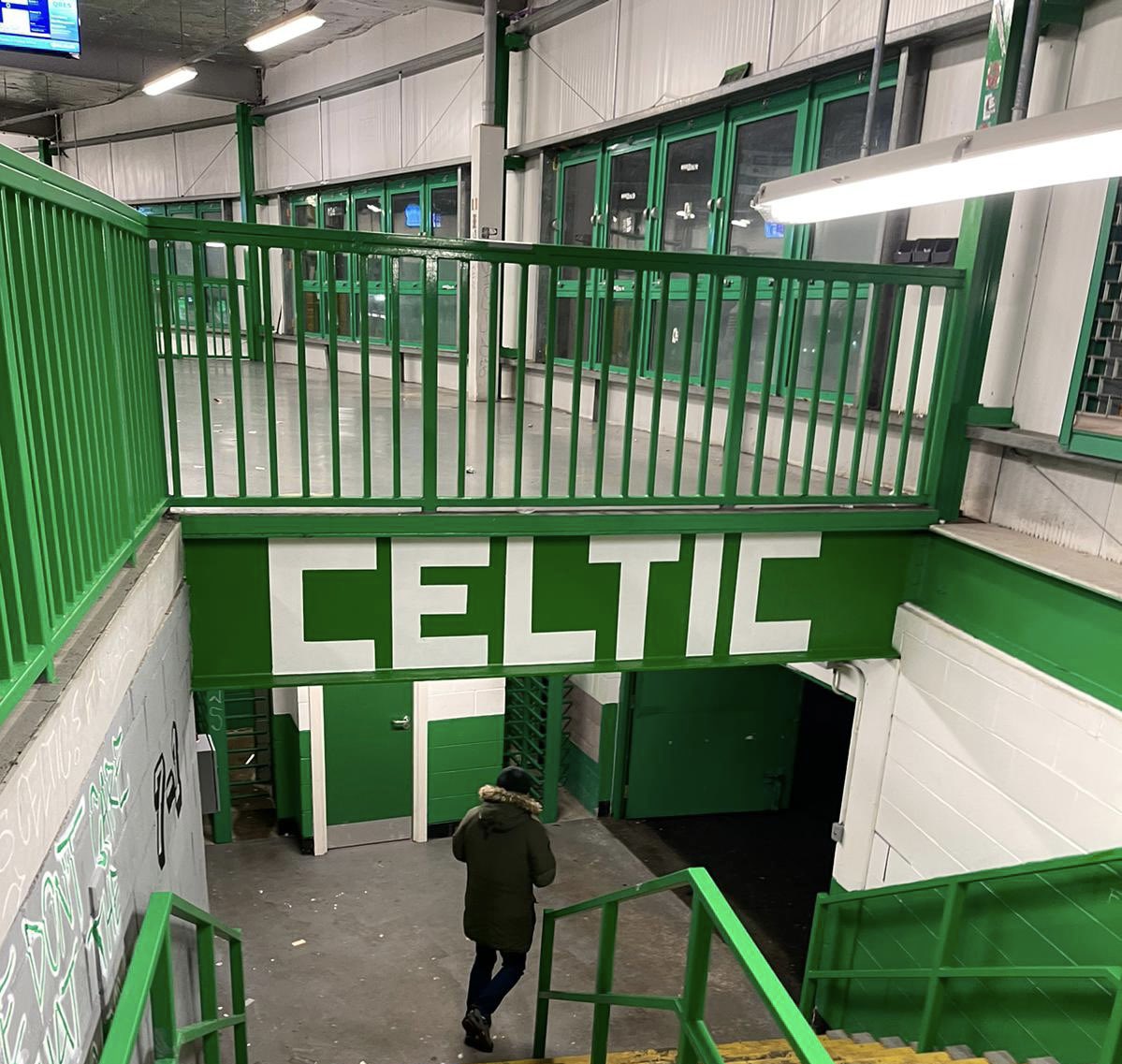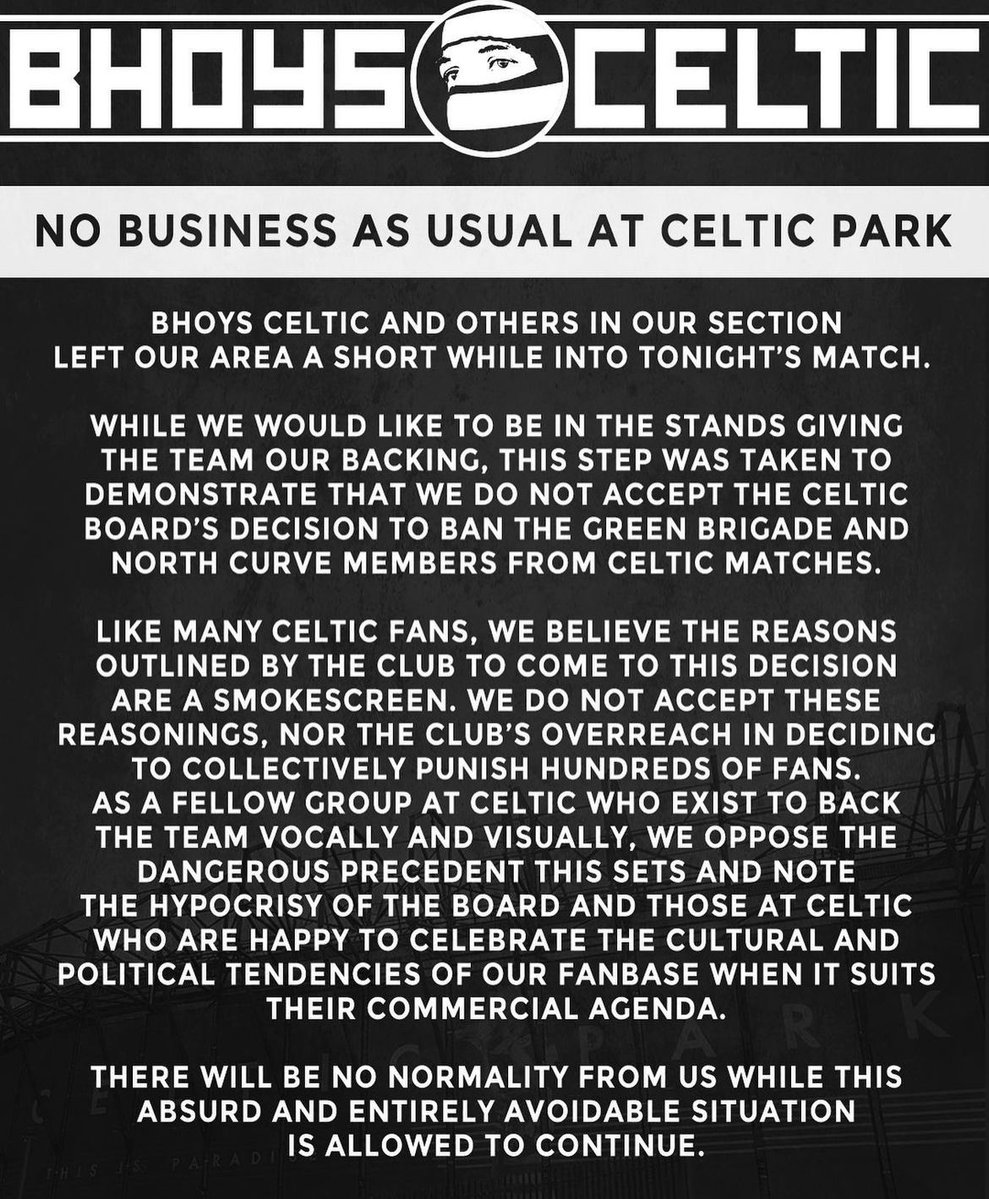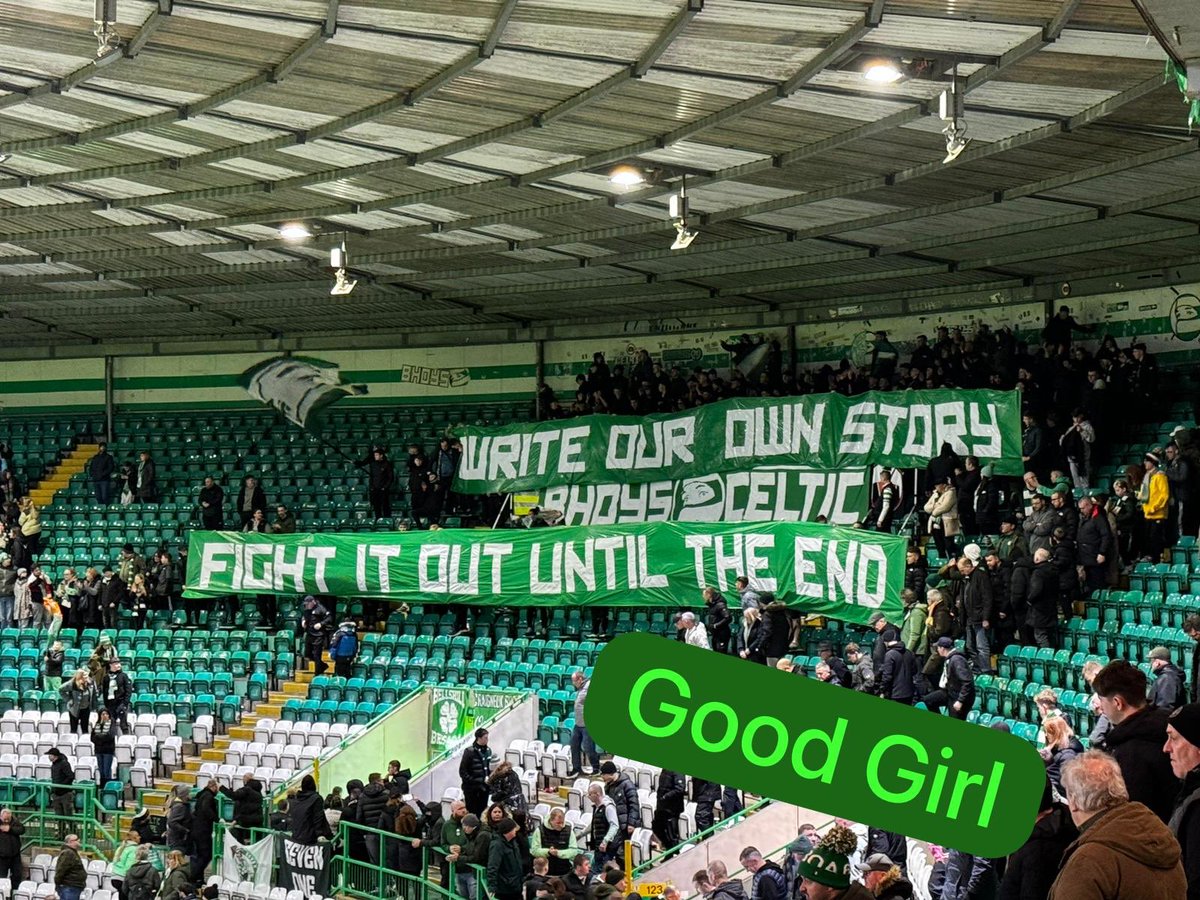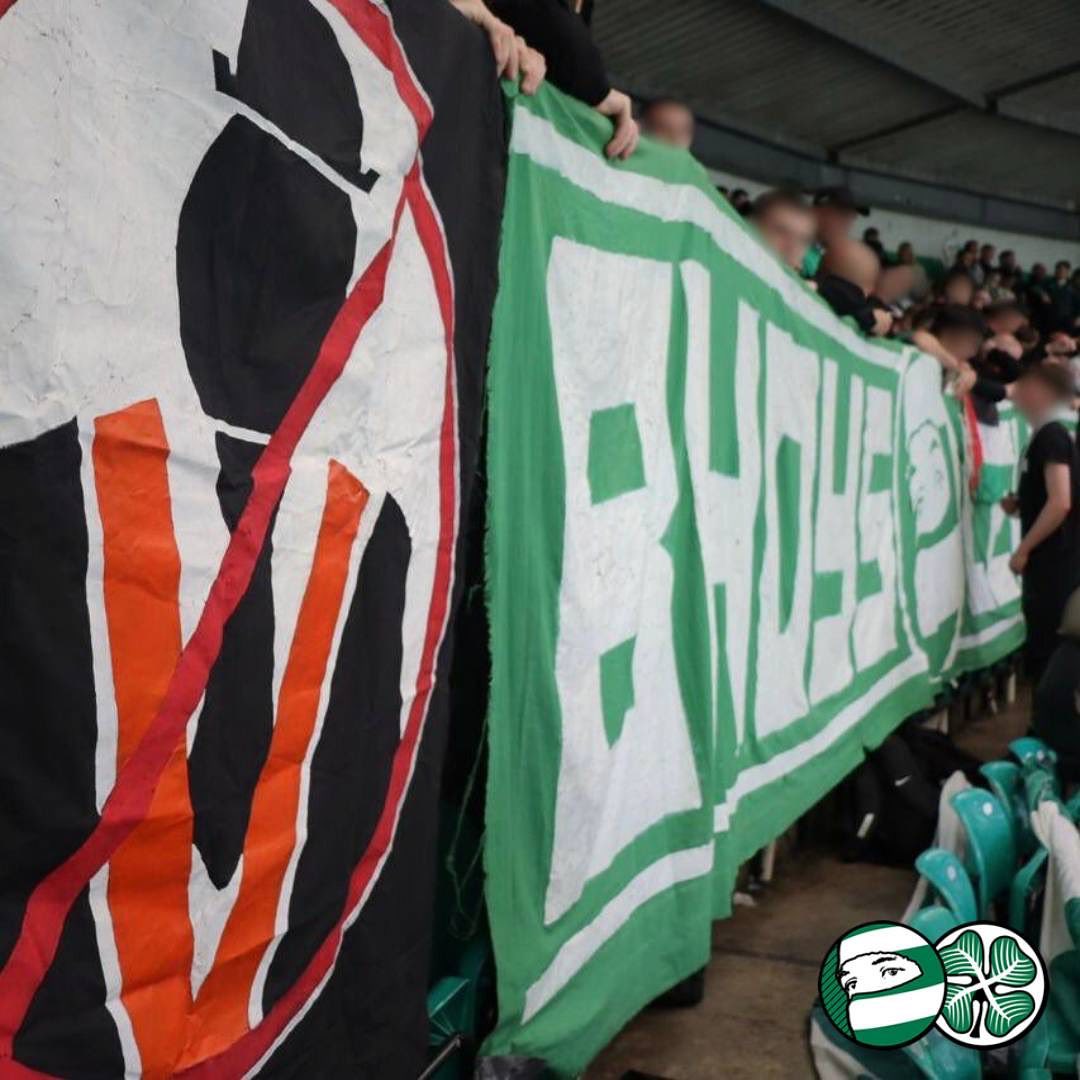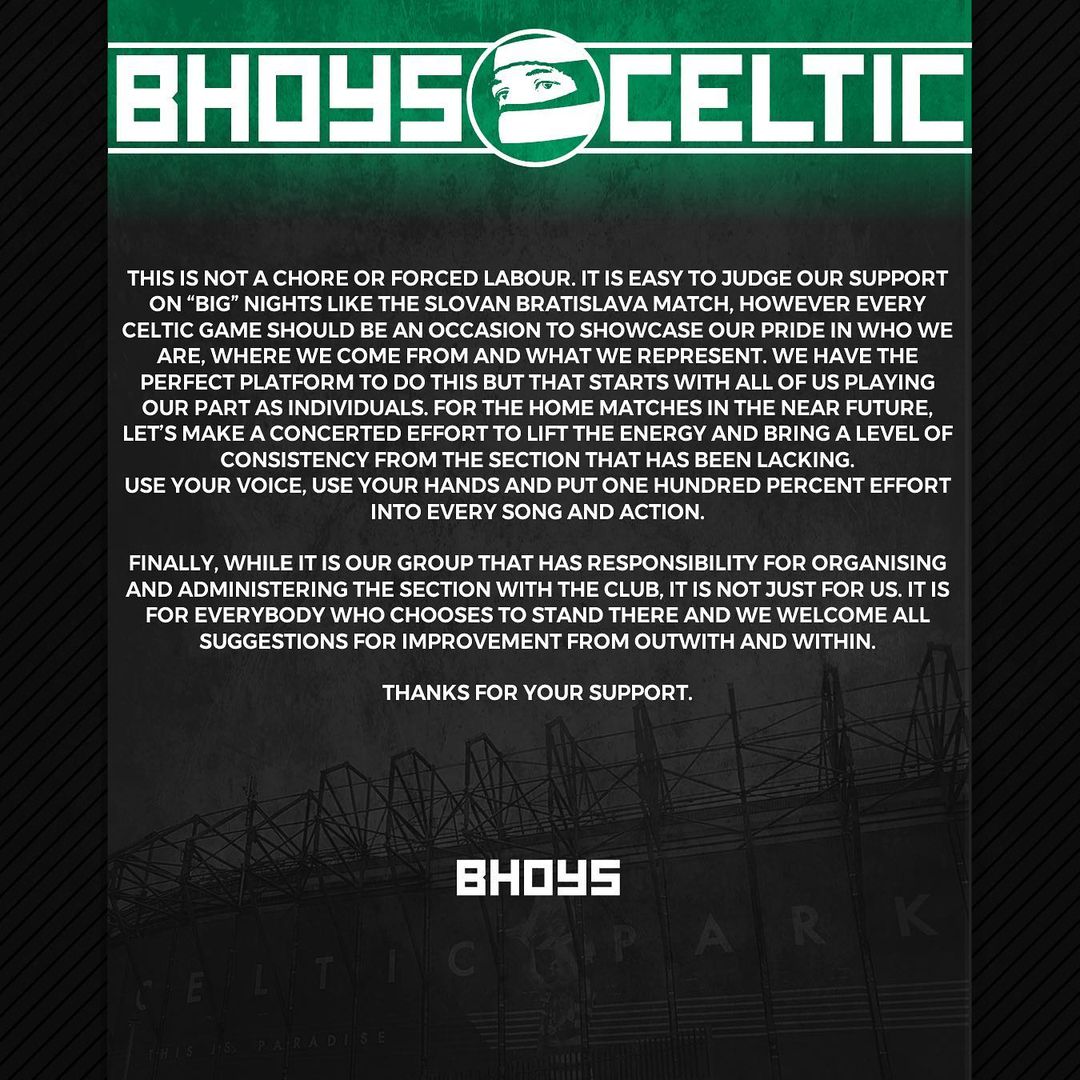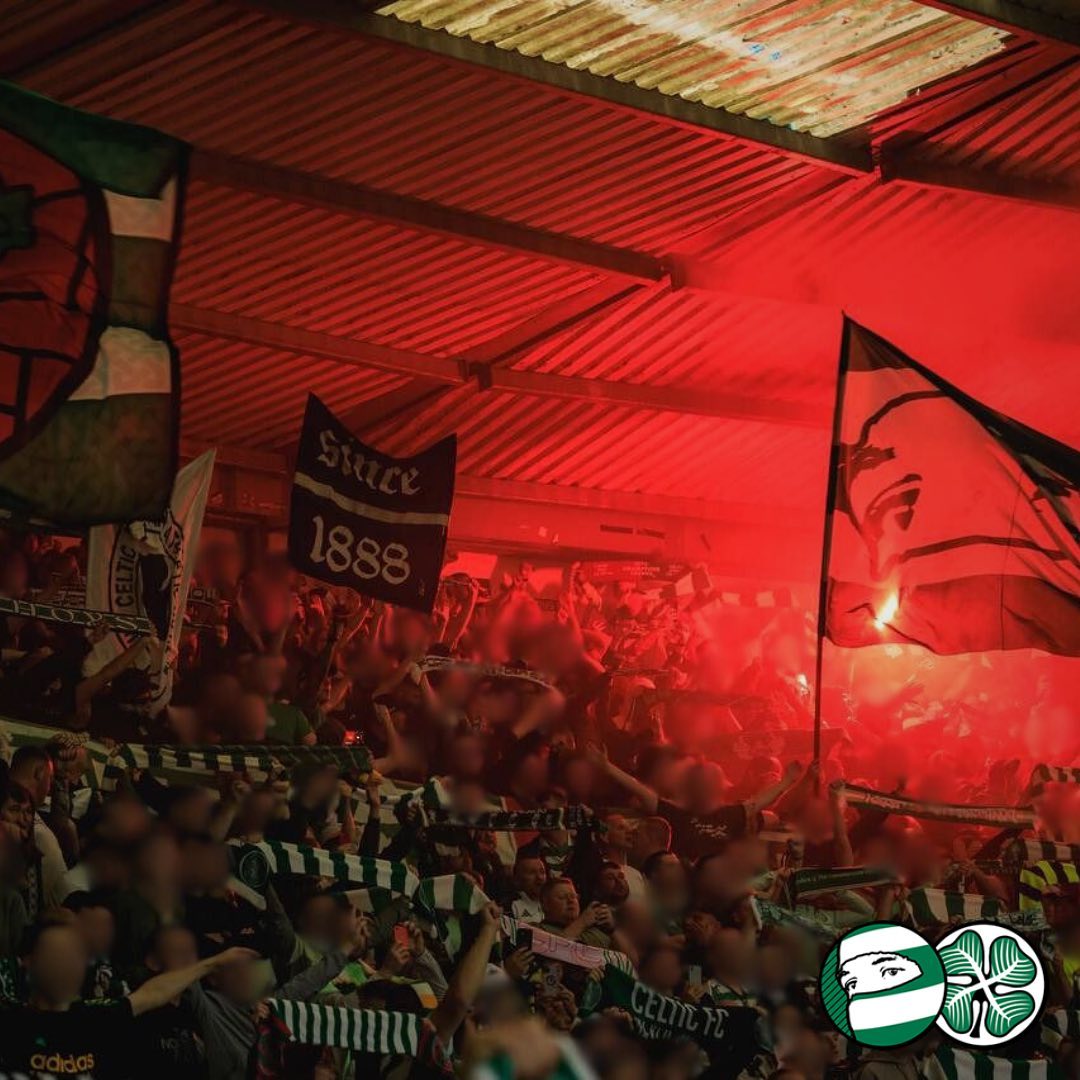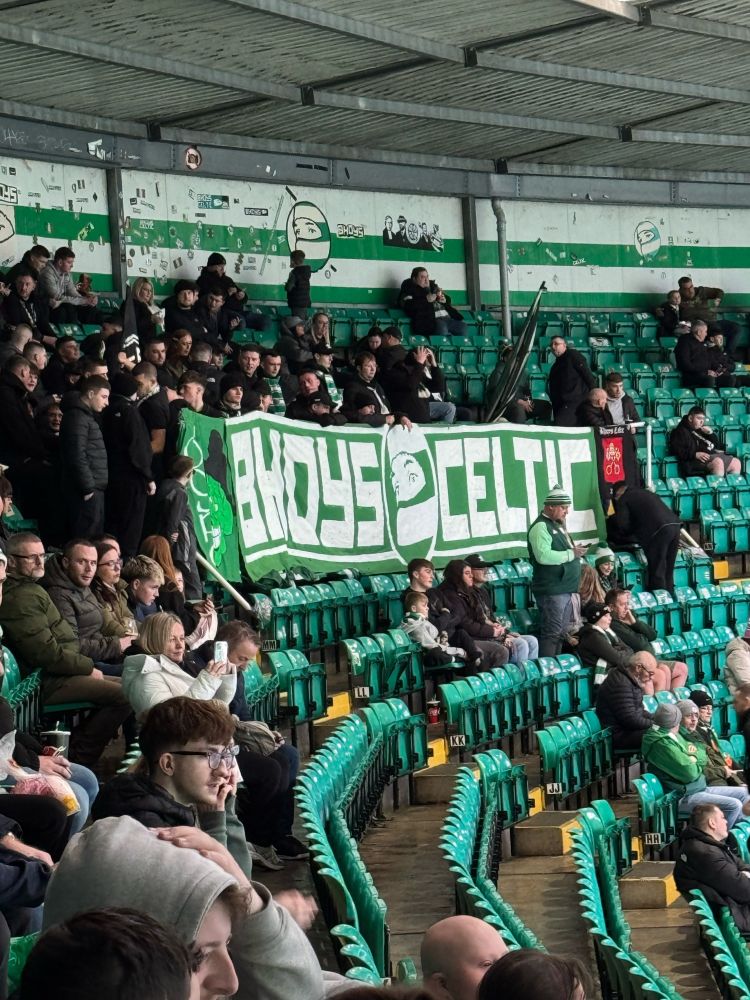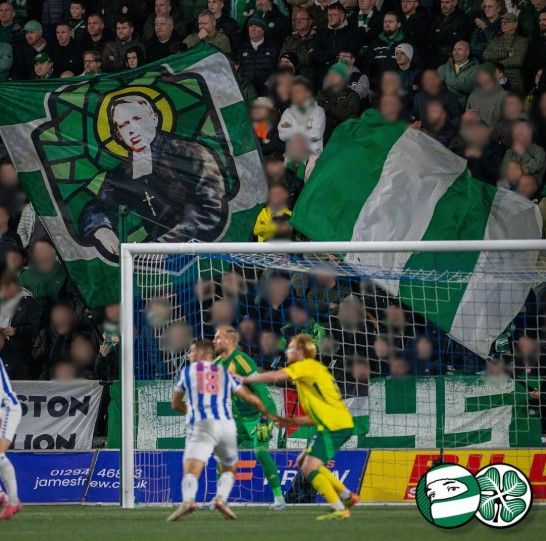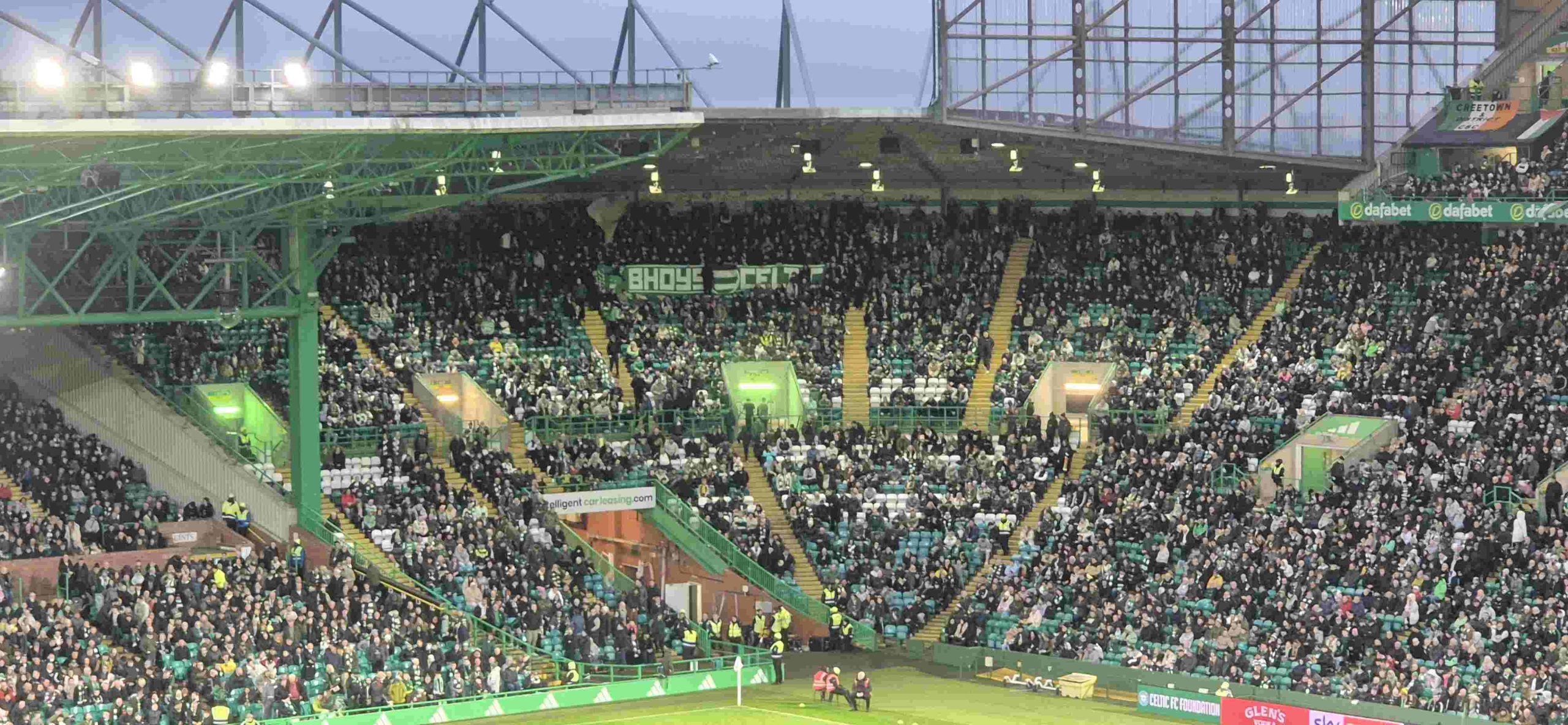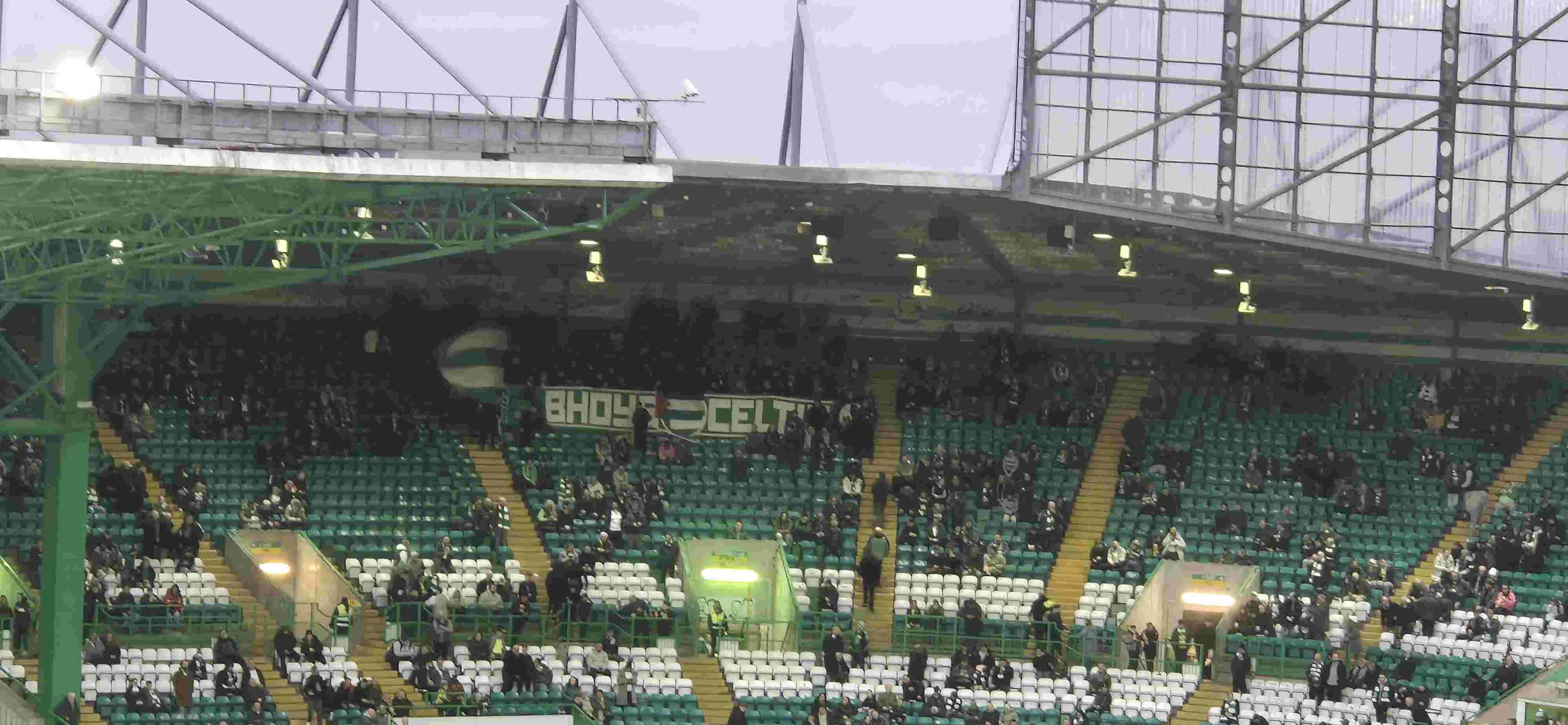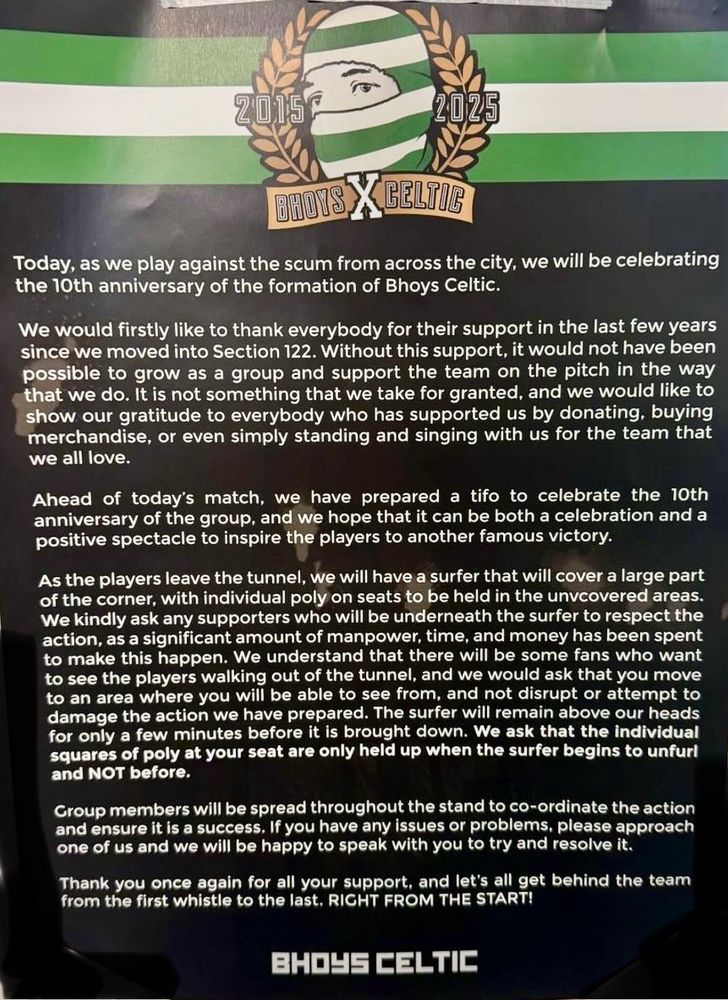Celtic Forums & Webpages | Supporters | Banners & Displays
Details
Group Title: The Bhoys Celtic
aka: Bhoys.Celtic, The Bhoys Ultras, The Bhoys Celtic
Formed: March 2015 (formally founded)

Background
Note: To be clear, on this site we DO NOT have any affiliation to this or any other of the Ultra groups, and we have no bias to one set or any others.
The Bhoys Celtic are a successor group that stemmed from the ‘SMV’ (Style Mile Vandals), a self-styled sub-street graffiti group that were loosely attached to the Green Brigade in section 111. The original SMV group were actually often much criticised, mocked & derided by the general Celtic support (in particular by Celtic da’s) in their early days but survived whilst other ultra groups floundered.
The group split away from the Green Brigade, renamed and regrouped in the North Upper stand in Celtic Park sections 444/5. In 2022 the ‘Bhoys Celtic‘ group were moved to Section 122 in the South Stand, diagonally across from the Green Brigade section so creating a cross stadium atmosphere.
Despite any differences in views between the ultra groups, in principle they do still follow similar Ultra supporters tropes, most notably organised displays, choreographed chanting, drums and banners. During the dispute between the Green Brigade and the board which led to the suspension of the Green Brigade group, the Bhoys Celtic opted to stand with their fellow Ultra Group shoulder to shoulder.
In general, The Bhoys Celtic group had mostly flown under the radar at Celtic in the early years, with the support & media lazily referring any atmosphere & displays etc as being solely attributable to the Green Brigade. Admittedly this had been mostly due to the larger presence and exposure of the Green Brigade, but especially as of 2022 the Bhoys Celtic had clearly become more visible with everyone aware of their efforts. They had grown in numbers, albeit still far smaller than the Green Brigade, but were still making some great atmosphere at the matches in their corner.
The disconnect between the two groups in the far away corners has been clear to all (especially with the singing & stadium chants), but to outsiders this was mostly seen as humorous (if not chilidish & comical). Regardless of any underlying rivalries between the groups, it has to date been mostly amicable, and everyone involved just wants to support Celtic.
There are justifiable criticisms (as there are with any Ultras groups), but any serious discussions on relevant issues are in general to be left off this site for other more appropriate forums.
[TBC]
Quotes
“We formed, officially, in 2015. Some of us had been members of the Green Brigade, but disagreements over various issues led to us leaving the group. Following this, the club ‘dispersed’ us across the North Stand Upper.
“We eventually conversed with Celtic and they subsequently agreed to relocate us to the one area (444 in the North Upper). This is where we have remained since.
“We aim to follow the ‘ultra’ style of support which was introduced by the Green Brigade, albeit in a much less choreographed way. In terms of size, we have a relatively small official membership but also count on a wider network of support which is invaluable to us being able to exist.”
Source: https://acsom.net/a-celtic-state-of-mind-exclusive-interview-with-bhoys-fan-group/
Links
Articles
The Green Brigade: Celtic gave us enough rope to hang ourselves
https://www.heraldscotland.com/news/13136449.green-brigade-celtic-gave-us-enough-rope-hang/
15th December 2013
Share
Green Brigade banners featuring Bobby Sands and William Wallace unveiled during the Uefa Champions League match against AC Milan at
‘CELTIC have basically said here’s your rope – and we’ve allowed ourselves and others to hang us.” That statement amounts to an admission of assisted suicide from Scotland’s most controversial group of football fans.
Fêted by Rod Stewart and lauded by England manager Roy Hodgson, the Green Brigade – Celtic’s group of “self-styled ultras” or hardcore fans – appears to have lost its war with the club and the goodwill of fellow supporters.
In the last month, the Green Brigade’s love/hate relationship with Celtic’s hierarchy has become one of just hate. One of its politically charged banners landed the club with another fine from European football’s governing body last week, and its association with the damage at Motherwell’s Fir Park stadium caused by setting off pyrotechnic flares and the breaking of seats is likely to see the club’s place in the experiment of Friday night football pulled.
As a result, more than 120 of the Green Brigade’s members and associates are suspended from Celtic Park, and its notorious Section 111 within the ground has been broken up.
In the popular imagination, they have had their status as Scottish football’s bête noir confirmed, shifting from a noisy, colourful, provocative and politically confrontational group to essentially hooligans with a fondness for Irish Republican paramilitaries.
Police Scotland, determined to make the contentious Offensive Behaviour at Football Act work, and whose officers have had regular brushes with the Green Brigade, could not have wished for better headlines.
It all seems a long way from their pivotal role in making nights like last season’s win over Barcelona among the best in living memory.
“Celtic have done what the police couldn’t do and that’s put the game beyond repair for us,” one member of the Green Brigade told the Sunday Herald.
“Will it end the group? Well, it could go either way, limping on and people could then chuck it. The moment might have gone. Lots of things are mounting up. The harassment from the cops and Celtic takes its toll.
“But when we got this thing going we were underground. We were raw. But we lost that. We went from one end of the spectrum to being in Rod Stewart’s book. The kids have ripped it up in the last weeks. I think we all have.”
The Green Brigade has a core of around 80 members, a decision-making inner circle of around 30 and a wider associated circle in its section within Celtic Park of around 350 people. Its successful underground merchandising operation would give the impression of a much larger group, however.
Police Scotland admits the group are not “casuals”. It has dismissed links with illegal groups in Northern Ireland, but expressed concern about the group’s use of pyrotechnics, the “vulnerability” of younger members and breaching the Offensive Behaviour Act via songs the force sees as falling foul of the legislation.
Since the introduction of the legislation, many of the Green Brigade’s members and associates have been arrested and brought to court for a breach of the act.
The Green Brigade was formed by no more than half a dozen members of a previous singing section, the Jungle Bhoys, who became disillusioned with that group around 2005 and wanted something more political which spoke to the Ultras scene of clubs such as Germany’s St Pauli or Livorno in Italy.
Soon they were active at anti-racism and STUC events, but still numbered only around a dozen marching behind their own banners. But when Celtic gave over a section of its ground to the burgeoning group, numbers started to snowball.
“By the time it’s 2010, the group gets Section 111 and we realise we’ve a movement on our hands.
“How do you get in? Well, you’ve got to turn up for games for starters. Then there’s paint nights, helping out with banners, setting up before big games in the ground. It’s almost like having another job and a lot of work goes into it away.
“To get in – it’s almost like an interview with people who are in your wider company. The group’s looking for people with different opinions, but on the three main topics.”
But controversy was never far away. A Remembrance Day banner demanding “No bloodstained poppy on our Hoops” brought widespread condemnation, and a Uefa fine for “illicit chanting” following the singing of songs referring to the IRA during the team’s Europa League run in 2011 was met with the notorious “F**k Uefa” banner at a subsequent game.
But for all his condemnation, Celtic’s chief executive, Peter Lawwell, kept the group on board, an acknowledgement of its input to the atmosphere at an otherwise moribund Celtic Park. Manager Neil Lennon also made a point of singling them out for praise when presented with the League trophy.
The Green Brigade member the Sunday Herald spoke to stands by their banners, including the ones linking IRA hunger striker Bobby Sands to William Wallace. However, several members of the Green Brigade have faced criminal action for singing the anthem Roll Of Honour, which commemorates the hunger strikes through the line “England you’re a monster”. They argue that Flower Of Scotland carries the same sentiment. He said: “The group was becoming part of the Celtic Park experience, part of the day trip; the section isn’t as hardcore as many think.
“But the banners over the last few years haven’t been about pushing the boat out and trying to annoy the club. Every single one of the banners had a deeply held belief and a point behind it.
“Like the Bobby Sands and William Wallace banner. A lot of people were scratching their heads. Even other Celtic fans were asking what this was about. But we knew. Anyone affected by the Offensive Behaviour Act knew. And if your audience is based around people getting arrested at the football, what better audience to make your point in front of?
“Forums and fanzines have had their day. It gets to the point where things build up a head of steam. The Offensive Behaviour Act came in and while people had reservations how it would affect them, it was not until it came in that we knew just how.
“And that’s not just the group. It’s those who were in our wider area and wider social circle. Away games is where the arrests are. Cops picking up easy targets, daft drunk kids who don’t realise the consequences of their actions and whose lives can be ruined for singing a song with their mates.
“And we get the label we do because people in Scotland aren’t willing, even now, to accept Irish Republican views as an acceptable political ideology. Back in the days of the Jungle, no-one was really picking up on this, but the last few years have thrown up a generation of tut-tutters who sang much much worse [songs] than we do now.”
If the knock-out blow was the Motherwell game, then the Green Brigade admit they “took their eye off the ball”. The emergence of a group of affiliated young Turks in the last year, the Style Mile Vandals (SMV) brought the edge of drunkenness and hooliganism to Celtic away fixtures. So who are the SMV?
“Well, they’re kind of the naughty wee brother who got kind of carried away. They’ve been on the go about a year, are younger kids and into graffiti and stuff. These are the guys out late at night putting up stickers and spray painting.
“The Union Bears [Rangers’ ‘ultras’] have something similar. But there’s a huge difference between the SMV and the Green Brigade, even if there’s an overlap of a few members.
“The Green Brigade kind of don’t want the notoriety as individuals; the SMV want to be the big boys. They see themselves as a group within a group and the Green Brigade are annoyed they’ve been pursuing their notoriety.
“My view? The recent pyro stuff hasn’t just been the SMV and the kids around the group. It’s easy enough to find online and it’s also cheap enough to find online and it’s also cheap enough for anyone to buy. However, a lot people need a bogeyman to blame.”
Pics
A Celtic State of Mind – Exclusive interview with ‘Bhoys’ fan group
A Celtic State of Mind – Exclusive interview with ‘Bhoys’ fan group
On Sunday, 23 February, 2020 / A Celtic State of Mind, Articles, Football / Leave a comment
Over the last few weeks, you may have read some articles on A Celtic State of Mind focusing on the ‘Twenty’s Plenty’ campaign. These pieces aimed to highlight some of the ways that this initiative can be positive for Scottish football, and how it can help fans who are taking the brunt financially, especially at this time of the year.
As part of the campaign, Celtic fan group ‘Bhoys’ have organised numerous banners displays throughout the season, with the most recent of those at the last home game against Ross County. The response to this has been very positive across the fan base and it was recently announced that The Celtic Trust would be adopting the campaign as one of its key priorities for 2020.
As a follow up to this, Colin Watt has been able to reach out to some of the guys that are part of the ‘Bhoys’ group to get their side of the story when it comes to the campaign. We also spoke about the group’s formation and what they would like to see changed regarding ticket pricing and other matters related to the Scottish football experience.
Listen to the latest episode of the award-winning A Celtic State of Mind with ACE CITY RACERS
Here is Colin’s interview with the Bhoys fan group:
Firstly, a big welcome to A Celtic State of Mind. Thank you for taking the time to join us for this interview. For those fans out there who aren’t overly aware of the ‘Bhoys’ group, can you explain the origins of the group, as well as your aims?
We formed, officially, in 2015. Some of us had been members of the Green Brigade, but disagreements over various issues led to us leaving the group. Following this, the club ‘dispersed’ us across the North Stand Upper.
We eventually conversed with Celtic and they subsequently agreed to relocate us to the one area (444 in the North Upper). This is where we have remained since.
We aim to follow the ‘ultra’ style of support which was introduced by the Green Brigade, albeit in a much less choreographed way. In terms of size, we have a relatively small official membership but also count on a wider network of support which is invaluable to us being able to exist.
The Twenty’s Plenty project isn’t the first time that fans groups have tried to introduce a similar price cap on Scottish football. What encouraged you to kick off this campaign?
We had noticed over the years that ticket prices were rising every season (in some cases even between first and second away games at certain grounds). The increases were only around £2/3 per rise, but the fact most away tickets this season were either touching on, bang on, or over £30 kick-started us into wanting to do something about these increases. We imagined this was probably a conversation just about every CSC was having, as ticket prices for our first away game were announced (Motherwell at £30).
We started to converse with fans of other clubs to get a wider view on the issue and find out what prices they were paying in other grounds around Scotland, and particularly what we were charging away fans (St Johnstone fans paid £32 and £30, restricted view, for the flag unfurling on the first game of the season).
Upon further investigation into prices, we also started to come across some shocking comparisons with ticket costs in England. Hamilton fans were asked to shell out £29 for the pleasure of a trip to Tynecastle on the same weekend that tickets for West Ham v Norwich were £27, being just one example that we came across.
After a few different meetings, we decided to take this to the stands and unveiled our first display away to Hamilton and took aim particularly at the League and SFA (Overcharging the Fans, Underselling the Game).
Some of the critics of the project have said that Twenty’s Plenty won’t work for some reasons – what would you say back to some of these criticisms:
– Home fans will get charged more than away fans;
– Supply and demand is what allows clubs to charge Celtic and Rangers fans these prices;
– The Board won’t go for this idea because it will cost them too much money;
– Celtic fans are protesting for this but charge a ridiculous amount for away fans with restricted view.
We were always expecting criticism, questions and queries to arise once we had the campaign started. It’s the first project of this nature we as a group have embarked on and it’s why we were particularly keen to meet with the Celtic Trust (who were very vocal in their support for Fans Against Criminalisation) to bounce ideas off each other and allow them to raise the questions that perhaps we hadn’t thought of.
The first issue they raised was also the question of any comeback regarding home supporters in comparison to what away fans are charged. We are calling on Celtic to set the trend initially with this campaign, but the idea is for all clubs to be on board, prompting a reciprocal saving for ourselves when visiting these grounds. There is an argument to be had that any unsold tickets on the day of the game are all profit that Celtic will not take into consideration, so these prices could also be lowered for walk up fans.
Taking this particular point further, it only need a quick look at home capacities around the country to see there should be a focus on this pricing and initiatives put in place to entice supporters back to their clubs (see St Johnstone not selling out one stand out for the visit of Celtic, whilst giving us three). In your last article you touched on attendances at Glasgow Clan which show they currently have higher home attendances than the likes of Hamilton and Livingston, statistics such as this show clubs must do more to bring fans in and think outside the box for ways to do so and subsidise the cost.
Football in general in Scotland is priced as a premium entertainment industry but the facilities, amenities and enticements don’t reflect this. We are asked to pay top-level prices for a product and experience which wouldn’t last five minutes in any other sphere and it is our passion for the game and our clubs that is being exploited. Add in to this the treatment of supporters by the football authorities and Police Scotland and this also would not be tolerated in any other sport. To us, we don’t see Scottish football as an entertainment industry, but unfortunately the clubs do and we feel if they want to continue with that train of thought then either our experience must change or, more importantly, the price must change to reflect what we are offered in Scottish football.
We absolutely take issue with the idea of keeping these prices for Celtic and Rangers fans simply because “they will pay”. The foundation behind the campaign is football fans in Scotland are being either priced out of or taken advantage of in terms of ticket pricing. We feel that just because you can fill an away end when playing Celtic or Rangers whilst charging £30 simply does not excuse doing so. It is simply taking advantage of supporters’ commitment and loyalty to their clubs and Scottish football as a whole. Now, whilst we are not entirely clear over which club sets the initial price, it is also plain to see the cost for one set of fans is then duplicated at the reverse fixture. More often than not at Celtic Park this leads to an empty away section.
The first hurdle we knew we would face is Celtic’s defiance to drop pricing without any windfall sitting on the other side. However, Celtic have always taken pride in being the first to set out new initiatives (see safe standing, On The Ball, etc) and we don’t see why this would be any different, particularly when you look back to the foundations of the club. Referring to your first article about the campaign, the loss Celtic would make on bringing this in would be like a drop in the ocean. Just to reiterate the numbers, were Celtic to drop prices for away fans to £20 and sell no extra tickets to these clubs we would see a rough loss of £3000 per game and £57,000 per season. To go back to making the same money they are now from away ticket sales, that would require an average of 150 extra supporters buying tickets. One thing we have become aware of from speaking to travelling fans of other clubs, is that Celtic is by far and wide seen as the worst match-day experience for away supporters. Sorting these issues, along with price, we are sure would see an increase in away supports at our ground, and if not, we feel the small amount lost would be worthwhile to kick start the drive to keep money in the pockets of supporters.
Some really excellent points there and you’re right, Celtic always seems to pride itself on being at the forefront of these new initiatives so it would make perfect sense for them to at least trial this scheme.
Touching back on the banner displays that you spoke about earlier, it has to be said they have been brilliant, especially the latest one in the home match versus Ross County. What has been the response to your banner displays?
For the most part, we have received a lot of support in response to the displays we have done so far this year. The simple idea of saving supporters money isn’t one that’s hard to get on board with. From speaking to fans around our area at the recent Ross County display, it wasn’t until it was laid in front of them they had noticed the severity of one month following Celtic. At the game, we had outlined that the cost for supporters in January alone was £199, purely on tickets. Since then, Aberdeen has also been added to the bill taking up the cost of January to £229 on tickets alone (before travel and other costs are taken into consideration).
Now, although this display in particular was solely aimed at our own club, we did also receive support online from a few supporters of the Dingwall club who had travelled down that day and detailed the cost of their ticket and travel which combined was £71. Any negative reaction that has come our way so far has simply been a misunderstanding of the campaign and an idea that we were only lobbying for cheaper prices for Celtic fans. It has also hit a brick wall with a few supporters who have openly admitted to it being hard to get on board with simply as it is being spearheaded by ourselves.
Touching on that last point about how you have spearheaded this campaign, just recently it was confirmed by a friend of ACSOM, and new Chairman of the Celtic Trust, David Low, that the Trust would be adopting the Twenty’s Plenty project as one of its key initiatives for 2020.
Was there any conversations between yourselves and the Celtic Trust before this was announced? What is it like to know that the project is now being backed by one of the biggest fans groups when it comes to voting rights at Celtic Park?
It is massive for us and the campaign to have the Celtic Trust on board. It was one of the first things we discussed doing when we decided to start Twenty’s Plenty for several different reasons. As mentioned earlier, we were well aware of the support and the work they (and in particular Jeanette) did for the FAC campaign, and whilst ticket pricing is not as severe an issue as the criminalisation of football supporters, we knew this experience would be key.
The dialogue they can open with the club, and the voice they have within our support, was of a level we likely couldn’t have reached on our own. Discussions had taken place for a few months about when we could meet, and we eventually got the chance on the morning of the Ross County game. The Trust listened to our views and ideas, bounced a few things off us and ultimately agreed to take this on board and hopefully take it as a resolution to the Celtic AGM in November.
I’m sure there are a lot of fans who will be patiently waiting to see how that goes at the AGM. Here at A Celtic State of Mind, we’ve been a vocal supporter of the Twenty’s Plenty project, with two recent articles written by myself, trying to get the word out to a wider audience – have you had any feedback from other fans’ websites or fans from other clubs?
The campaign has been picked up after almost every display we have done so far, with the BBC running a few articles and Kieran Devlin at The Athletic also contacting us for comment on an article he wrote on ticket pricing. As for other clubs, we have had limited contact. We have spoken with the groups both at Hibs and Motherwell about joining the campaign and hope this is something they decide to do. Fortunately for us, St Mirren have taken to getting on board and unveiled displays against ticket pricing at Celtic Park, Tynecastle and Easter Road. Dunfermline also unveiled a banner away to Dundee United to protest ticket pricing. We hope the more we do, the more it will entice other clubs to do similar and we can soon see fans of all clubs pressuring their own clubs.
It must be said, the more people that push for the movement, the easier, in theory at least, it should become to get it implemented.
As you mentioned, it’s good to see that other teams are starting to get on board with the ideology of the project. What are the plans for the Twenty’s Plenty project going forward? Should we expect to see more banner displays soon or, now that you’re working with the Celtic Trust, what can be done to take this to the next level?
The plans are to continue as we have done for the past six months. We will continue to protest with banners, amongst other things, for the remainder of the season and into next. We will take aim at all clubs across Scotland, particularly Celtic, and perhaps also look to the league and SFA as well. We are aware of the concerns from clubs over costs if these are to drop, but this opens us up to have the conversation about how to create more money in our game and at our clubs.
Aberdeen recently protested the current alcohol ban still in place across grounds in Scotland and we feel this is something clubs should be lobbying for to help ease the burden on them for ticket prices. This is an idea which always brings up opposition, but we realise that the reintroduction of alcohol at games means supporters need to take responsibility for their own behaviour. There is no reason this should not be trialled as most supporters would understand with concessions such as alcohol at football comes responsibility.
We have looked into the revenue generated by clubs in England from alcohol sales and see no reason why this can’t be replicated in Scotland (Tottenham’s ground, for instance, is open for hours after full-time hosting fans). For this issue in particular, today’s match-going supporter is being held to account for something that happened when fathers and grandfathers of the current generation were attending matches.
Ideas such as unallocated seating, which Aberdeen also trialled in the Scottish Cup recently and which helped them sell out their Merkland Stand for a home game against Dumbarton, are things which clubs should be looking at and thinking of to make the experiences better for supporters. We also realise that clubs could point to the recent UEFA report that 43% of revenue is made through gate receipts to counteract any attempt at reducing costs. But there is an argument to be made, that if this is the most important source of revenue in our game, why do we have any kick-off other than Saturday 3pm? And why aren’t we doing more to sell out these stadiums and bring supporters in if we are relying on this revenue?
With the Trust now on board, this gives us a different dynamic and an avenue in which we can start to discuss this with our own club and plant the seed within to start a conversation about what can be done and what we feel we should be doing as a club. As mentioned earlier, the Trust are looking to take this to the AGM in November, but we feel a lot of work can be done between now and then and hope to make significant inroads before the Celtic AGM.
It’s a great point made about the alcohol ban. We are now approaching 40 years since the game brought in the alcohol ban in Scotland, and it is an absolute farce that football fans in Scotland can’t purchase a beer in the ground.
It sounds like there’s a lot of work going on in the background with future banners planned and working with the Celtic Trust. We really appreciate you taking some time to chat with us but, before you go, what would you say to fans both of Celtic and of other clubs, to encourage them to join in with the movement?
The point we would like to put across to other clubs is just to reiterate that this campaign was started and will continue to be for the benefit of supporters of all clubs across Scotland. There is a goal and it is something we believe we can achieve much quicker if fans start pressuring their own clubs to get on board and explore other avenues to make fans’ experiences better and bring people back to the Scottish game. Fans are what makes Scottish football and we believe it is time that our clubs and our representative leagues and associations started to put us at the forefront of their thinking.
In the end we hope that, as discussion progresses, it will lead to a cheaper and more enjoyable match-day experience for both home and away supporters.
I think we can all agree that Scottish Football is in dire need of changes and, whether it be some of the ideas that you have mentioned today or something we haven’t thought about yet, what we really need is a team to take the initiative and make the first step.
Thank you very much for your time, it was certainly great to hear your thoughts about rejuvenating Scottish Football and, as you know, we are 100% behind the Twenty’s Plenty idea.
We look forward to seeing what comes next and hopefully we can continue to work with yourselves and the Trust to continue the drive.
Thanks and good luck from all at A Celtic State of Mind.

